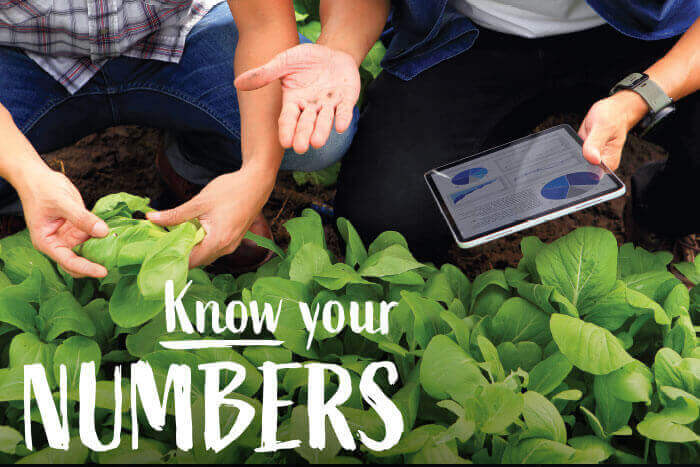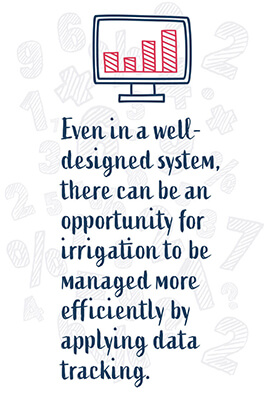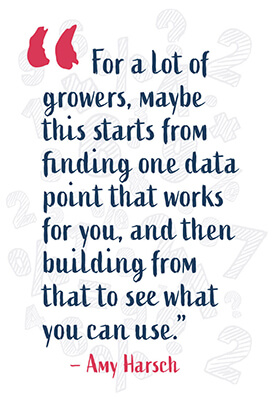
Some things will always be true for ag producers, such the fact that plants need water. But increasing regulation and focus on responsible water use mean that growers are having to find new ways to solve irrigation issues.
One tool that has helped ag producers in the goal to maximize irrigation efficiency is the collection and analysis of data. Getting more specific information has helped growers make more informed decisions while reducing costs, all while developing better water management practices.
Mark Owens, who runs an alfalfa farm near Crane, Oregon, is responsible for about 5,500 acres with groundwater irrigation. In 2015, his local water resource department approached his community to say that it had over-appropriated its basin by a significant amount. Owens got involved in a collaborative process to determine whether that was accurate and found that he needed to make some changes.
“I learned that we were going to have to figure out how to use less water and grow the same amount of crops,” Owens says. “I thought, ‘How can I be proactive and start that?’” He knew he and his local community needed to get creative if they were going to manage the difference.

He took a look at the setup of his irrigation systems to understand how water use on his property was determined. “We quickly came to learn that they were designed to meet the highest evapotranspiration during the hottest day of summer,” he says. In an effort to make sure the crops always had what they needed, the system was arranged to target the worst-case scenario as the goal for watering for every single irrigation event.
That sparked an investigation of what ET really meant for his crops and how he could find out what his rates were. Once armed with that knowledge, he wanted to know how he could actually use that data to make a difference and keep his crops in the best shape possible with fewer inputs.
Things are a little different for Amy Harsch as she works alongside growers near Wood River, Nebraska, where water costs are still low and restrictions aren’t as heavy as other states. But that doesn’t mean that growers aren’t able to reduce costs and prepare for the restrictions that will be coming eventually. “They really want to learn to be able to grow more with less,” she says. “It’s a puzzle piece of trying to find that happy medium, to find where you are making the most out of every ounce of that water.”
It isn’t just a question of water use, as irrigation affects all other inputs. “Fertilizer prices are through the roof right now,” says Harsch. “Every drop of that is worth a lot of money. To flush it through a soil profile because you irrigated at the wrong time and the crop didn’t get to use it, you might as well just throw money into a good old Nebraska breeze.”
Mimar Alsina, PhD, who works on irrigation for E&J Gallo Winery in Modesto, California, has been collecting ET data connected to irrigation for about 10 years. Connecting that information to OpenET, Washington, D.C., and other remote sensing data has been one opportunity to put that collection to use in field production through a pilot project.
She met with the ranch manager every week to educate them on how that information could be used to determine the irrigation system’s efficiency with the grapevines, as compared to their original targets calculated using a crop coefficient. Because growers could previously only really measure how much water they were putting down, that’s a comfortable standard for some who aren’t familiar with using real-time evapotranspiration data.
“People didn’t have actual ET available to use. It seemed like you couldn’t measure how much water was being used by the crop,” Alsina says. “Every time there’s new data that’s available, it’s like, how do we put it in the game? How do we use it?”
Alsina started work with one field where the manager had been working in that position for several years and was already doing well with responsible irrigation practices. “We used that as a benchmark,” she says. “Then, from calculating irrigation and using the actual ET, and comparing that to what they were doing, we saw that they were practically the same.” But even with that high level of expertise in irrigation practices, working with the actual ET sometimes allowed for better water efficiency without a change in quality. “What we saw is there really is a potential even for a place where things were done well to have an opportunity to use actual ET to adjust the irrigation and save water.”
 They had a savings of about 10% of water use altogether, she says. In some cases, it wasn’t about the total amount of water being used, but how and when it was being applied to be more efficient.
They had a savings of about 10% of water use altogether, she says. In some cases, it wasn’t about the total amount of water being used, but how and when it was being applied to be more efficient.
Owens talked with extension professionals and checked out symposiums to see how conservation would improve his irrigation efficiencies. Not all of the details he picked up were specifically about tracking his water use: He learned that he could save about 20% of his overall water use for alfalfa just by watering with the sprinkler heads below the canopy, for instance. But gathering information gave him what he needed to rework his irrigation.
“If I know I’m not going to have much evapo-transpiration, then I can design my system to put out less water,” he says. “That’s what we started to do. We started to get data, and then design the irrigation systems to meet the average demand that our crop might incur, knowing that we can store some of that water in the soil profile for those real hot days.”
He worked with weather stations to get more exact data on what his crops were facing and got involved with OpenET for a better sense of ET rates.
“We keep really good records for the amount of water we apply,” says Owens. “We’ve reduced our water usage by about 18% to 22%.” One side effect that Owens hadn’t initially been anticipating is that by managing his overall water usage, he also got better control of some of his energy costs, as he was using less electricity to pump water from the ground. “We’ve actually reduced our electricity bill by that same amount, almost.”
He started with his average pivot putting about 7.5 gallons of water per minute per acre based on that worst-case scenario. With the new system designs, that reduced to about 6 gallons per minute per acre.
Getting a better understanding of the data gave him the ability to know how to incorporate lower-pressure systems for his sprinkler heads while still retaining effectiveness. “Our motto is ‘More crop per drop,’” he says. “It’s conservation with efficiencies, without reduction of yield.”
Before diving into collecting more data, the information he worked with in making decisions felt similar to notes on the back of a napkin, Owens says. But with a more expansive program involving ET, he and his crew can get a close-up read of how much water his crops are actively using and make decisions based on what’s happening in the field.
When Owens comes across a technology or technique that he feels makes sense and has a direct application, such as watering beneath the canopy, he puts it into practice as quickly as he can throughout his crops. He still suggests that it’s usually a better idea to test out new ideas on a small area before scaling up, and always back up those plans with some framework of data.
“I’ve always embraced technology. I’ve always been a data nerd,” he says. “When something works out to me mathematically, I don’t have a fear of trying it. But it took us a while to figure out where the data was so we can make those informed decisions.”

Building data collection into irrigation practices can be a little off-putting for some growers who aren’t as comfortable with it overall. Try not to look at it as a way to point out irresponsible water use, but instead as a benchmark for finding ways to be more efficient, says Alsina. The data collection could help plan out irrigation decisions for future crops and set correct goals for quality and yield in production objectives.
“We know exactly for the first time, not only our targets that we calculate, but what really happened in the field every moment,” she says. “It’s a way to check, when before there was no way to check.”
It can also be a point of pride as more efficient irrigation practices are put into place, where growers can show off how they’re getting the same yield or quality while using less water, she says.
Start by connecting with the water provider to get solid statistics on current water usage to use as a beginning point, he says. Then, work to fill in some of the blanks in your data to figure out why that’s the amount of water being used. Working with the irrigation provider and extension experts can go a long way to getting more definite plans in place for more effective irrigation.
It’s important to remember that even the most efficiently designed system, if poorly managed, isn’t actually efficient, Owens says. It takes expertise and a commitment to both collect data and actually pay attention to it to get the most out of it.
One challenge can be that there are so many different platforms for water use and other data collection. “It just becomes a crazy chaos of ‘This manages the tractor data and this manages the combine data and this manages the water data,’” Harsch says.
 When starting out, remember that irrigation data collection is just a resource like anything else on the farm. “It’s just like your tractor or combine. It is not the end-all, be-all,” she says. “It still has to have human interaction.” While there are many options available for tracking different kinds of data collection for irrigation, it doesn’t have to be overwhelming. Take a look at your crops and production goals, and determine what would be a useful place to start or to have more concrete numbers to work with.
When starting out, remember that irrigation data collection is just a resource like anything else on the farm. “It’s just like your tractor or combine. It is not the end-all, be-all,” she says. “It still has to have human interaction.” While there are many options available for tracking different kinds of data collection for irrigation, it doesn’t have to be overwhelming. Take a look at your crops and production goals, and determine what would be a useful place to start or to have more concrete numbers to work with.
“For a lot of growers, maybe this starts from finding one data point that works for you, and then building from that to see what you can use,” says Harsch. “Take it piece by piece, because truly you will find it overwhelming if you take on too much at once.” It might be worthwhile to plan to add a little bit of new technology each year.
Don’t approach data collection as a replacement for water management and experience or generational knowledge, Alsina says. “You still need to know how to manage,” she says. “People cannot think this is a substitute. It’s a layer of help to be more efficient. But you still have to have your own target.”
8280 Willow Oaks Corporate Drive | Suite 630 | Fairfax, VA 22031
Tel: 703.536.7080 | Fax: 703.536.7019
HOME | ABOUT US | ADVERTISE | SUBSCRIBE | CONTACT | PRIVACY POLICY | IA ANTITRUST STATEMENT